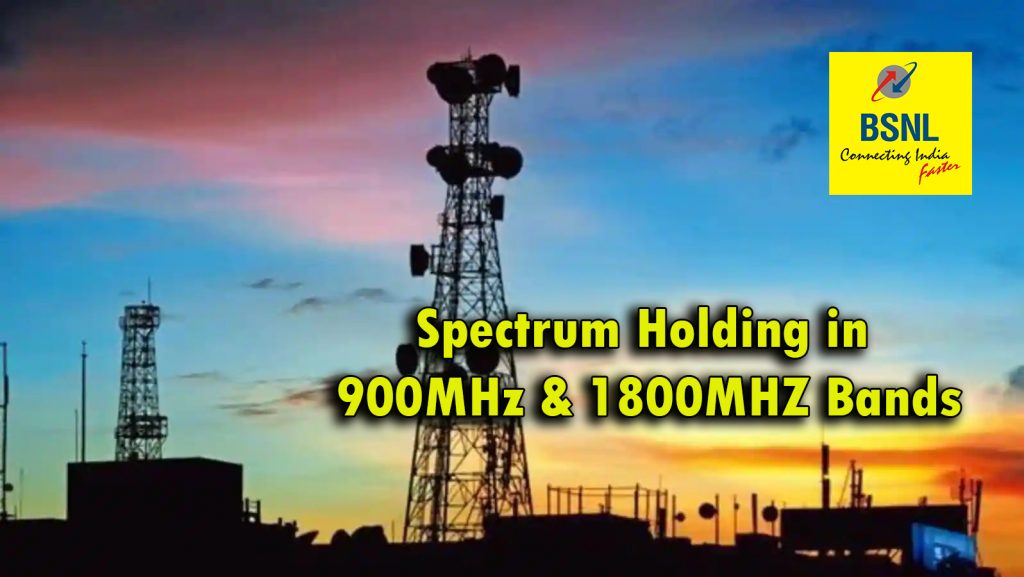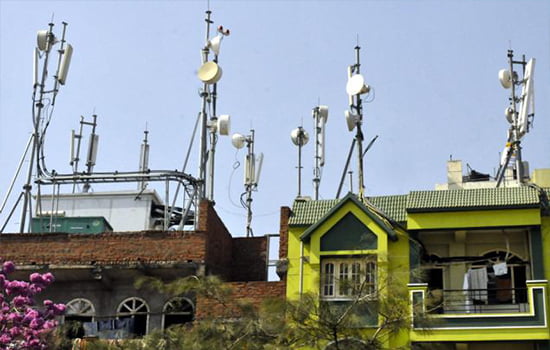BSNL – The One and Only Public Sector telecom giant – completes the surrender of certain carriers in the 2G spectrum already allocated in 900MHz and 1800MHz bands all over India. In order to optimise spectrum usage charges, and thereby to reduce expenditure, BSNL corporate office issued directions to all telecom circels to examine the requirement of 2G spectrum in both 900MHz and 1800MHz bands. BSNL was holding 6.2MHz bandwidth in 900MHz band in all the telecom circles except Jammu & Kashmir. In Jammu & Kashmir, BSNL was holding 8 MHz bandwidth in 900MHz 2G spectrum.

Similarly, BSNL was allocated 3.8MHz bandwidth in 1800MHz band in almost all telecom circles for 2G services. In May 2019, BSNL surrendered 1800MHz spectrum band from certain telecom circles like – Bihar (Including Jharkhand), Gujarat, Kolkata, Maharashtra and Rajasthan to DoT. Based on the feedback received from field units/telecom circles, BSNL corporate office submitted their request to DoT (Department of Telecommunication) for surrender of certain carriers in 2G spectrum (In 900MHz & 1800MHz band) which is already allocated to BSNL.
DoT approved BSNL’s request for surrender of spare / excess spectrum and instructed BSNL units to vacate / surrender their unutilised / under-utilised spectrum in 900MHz & 1800MHz bands latest by 31st August 2021. As per the instructions from DoT, BSNL completes the surrender of certain carriers in both 900MHz and 1800MHz spectrum which was previously used for 2G services.
BSNL Spectrum Holding in Kerala Telecom Circle
BSNL Kerala telecom circle is one of the best telecom units of BSNL which generates highest revenue as compared to all other units of BSNL. Out of the 22 telecom circles, BSNL surrendered certain carriers in 900MHz 2G spectrum in all the circles except Kerala. In Kerala circle, BSNL will be holding the entire 6.2MHz band for 2G servies. Whereas in 1800MHz band, BSNL Kerala Circle was asked to vacate / surrender the 1.8MHz bandwidth from the allotted bandwidth of 3.8MHz. After completing the surrender, BSNL Kerala Circle will be holding 2MHz bandwidth in 1800MHz spectrum. The surrender of excess carriers in 1800MHz band is expected to completed by 30th September 2021 in Kerala circle.
Details of surrender of spectrum holding in 900MHz & 1800MHz bands by BSNL across all the telecom circles.
BSNL 2G Spectrum Holding in 900MHz band across all Telecom Circles | ||||
Sl No | Service Area (Telecom Circle) | Existing Spectrum Holding (In MHz) | Surrendered Spectrum (In MHz) | Spectrum Retained after 31-08-2021 (In MHz) |
1 | Andhra Pradesh | 6.2 | 0.6 | 5.6 |
2 | Assam | 6.2 | 1.2 | 5.0 |
3 | Bihar | 6.2 | 1.2 | 5.0 |
| 4 | Delhi | 6.2 | 1.2 | 5.0 |
| 5 | Gujarat | 6.2 | 1.2 | 5.0 |
| 6 | Haryana | 6.2 | 0.6 | 5.6 |
| 7 | Himachal Pradesh | 6.2 | 0.6 | 5.6 |
| 8 | Jammu & Kashmir | 8.0 | 3.0 | 5.0 |
| 9 | Karnataka | 6.2 | 0.6 | 5.6 |
| 10 | Kerala | 6.2 | — | 6.2 |
| 11 | Kolkata | 6.2 | 1.2 | 5.0 |
| 12 | Madhya Pradesh | 6.2 | 1.2 | 5.0 |
| 13 | Maharashtra | 6.2 | 1.2 | 5.0 |
| 14 | Mumbai | 6.2 | 1.2 | 5.0 |
| 15 | North East | 6.2 | 1.2 | 5.0 |
| 16 | Orissa | 6.2 | 0.6 | 5.6 |
| 17 | Punjab | 6.2 | 0.6 | 5.6 |
| 18 | Rajasthan | 6.2 | 0.6 | 5.6 |
| 19 | Tamilnadu | 6.2 | 0.6 | 5.6 |
| 20 | Uttar Pradesh (East) | 6.2 | 1.2 | 5.0 |
| 21 | Uttar Pradesh (West) | 6.2 | 1.2 | 5.0 |
| 22 | West Bengal | 6.2 | 0.6 | 5.6 |
BSNL Kerala Circle is the only telecom circle holding the entire block of 6.2MHz bandwidth in 900MHz spectrum whereas almost all other telecom circles are holding just 5.0MHz bandwidth to maintain 2G services. 900MHz band spectrum is considered to be the best band for maximum coverage. As per latest TRAI reports, BSNL is maitaining wireless market share of 24.04% in Kerala Telecom Circle and hence 900MHz band is very much essential to retain their existing customers.
BSNL 2G Spectrum Holding in 1800MHz band across all Telecom Circles | ||||
Sl No | Service Area (Telecom Circle) | Existing Spectrum Holding (In MHz) | Surrendered Spectrum (In MHz) | Retained after 31-08-2021 (In MHz) |
1 | Andhra Pradesh | 3.8 | 3.8 | 0 |
2 | Assam | 3.8 | 3.8 | 0 |
3 | Bihar | 0 (Surrendered 3.8 MHz in May 2019) | 0 | 0 |
| 4 | Gujarat | 0 (Surrendered 1.2 MHz in May 2019) | 0 | 0 |
| 5 | Haryana | 3.8 | 3.8 | 0 |
| 6 | Himachal Pradesh | 3.8 | 3.8 | 0 |
| 8 | Jammu & Kashmir | NIL | NIL | NIL |
| 9 | Karnataka | 3.8 | 3.8 | 0 |
| 10 | Kerala | 3.8 | 1.8 | 2.0 |
| 11 | Kolkata | 0 (Surrendered 3.8 MHz in May 2019) | 0 | 0 |
| 12 | Madhya Pradesh | 3.8 | 3.8 | 0 |
| 13 | Maharashtra | 0 (Surrendered 3.8 MHz in May 2019) | 0 | 0 |
| 14 | North East | 3.8 | 3.8 | 0 |
| 15 | Orissa | 3.8 | 1.8 | 2.0 |
| 16 | Punjab | NIL | NIL | NIL |
| 17 | Rajasthan | 0 (Surrendered 1.8 MHz in May 2019) | 0 | 0 |
| 18 | Chennai Telecom District | 3.8 | 1.8 | 2.0 |
| 19 | Tamilnadu (Excluding Chennai) | 3.8 | 1.8 | 2.0 |
| 20 | Uttar Pradesh (East) | 3.8 | 3.8 | 0 |
| 21 | Uttar Pradesh (West) | 3.8 | 3.8 | 0 |
| 22 | West Bengal | 1.8 | 1.8 | 0 |
BSNL to hold 1800MHz spectrum only in 4 telecom circles!
BSNL will be holding 1800MHz band for 2G services in four telecom circles namely – Kerala, Orissa, Chennai Telecom District & Tamilnadu circles only after 31st August 2021. While the same will be surrendered to DoT in all other telecom circles. BSNL is having sufficient market share in all these 4 telecom circles and hence 2G spectrum in 1800MHz band is essential to provide carpet coverage in cities where population is relatively high.
2G Spectrum Bands in India
India is also one of the largest telecommunication markets in the world having large geography and population. India has also the largest growth of mobile subscribers and technology development as compared to any other country in the world. All operators in India, except Jio operates in 2G technology (GSM technology) and all of them are having significant number of 2G subscribers. In India, telecom operators are operating in 900MHz and 1800MHz bands for their 2G GSM mobile services.
Advantages of 900MHz band over 1800MHz
The 900 MHz band is superior to the 1800 MHz band in terms of coverage. It is because of the propogation characteristics of radio waves. Radio waves with lower frequencies can cover maximum distance whereas radio waves with higher frequency can cover only a short span of distance. Radio waves in 900MHz band will help telecom operators to provide more indoor coverage as compared to 1800 band. It means, an operator need less number of mobile towers to cover an area with 900 MHz band.
In addition, the 900 MHz band has a superior commercial ecosystem than 1800 MHz. The 900 MHz frequency band has been in use for mobile communications globally for over 20 years and as a result technology standards have been better developed compared with 1800 MHz band. Telecom operators are using 1800 MHz band mainly in city areas where the number of mobile towers will be high and hence coverage issue will not arise. 1800MHz in city areas also helps operators to offer higher bandwidth as compared to 900MHz band.
Dear readers, please share your views and opinions about this latest news about 2G spectrum surrender by BSNL via comments with us. How many of you are using BSNL 2G mobile services? Please do share your feedback about Voice Quality and Coverage via comments with us. Whether this move would help BSNL to improve its financials?







1 Comment
I wonder when BSNL will provide usable 4G service in Ernakulam (not namesake as in Thrissur). By then, I guess, either BSNL or myself will have had reclined for the final sleep realising there are miles to go.